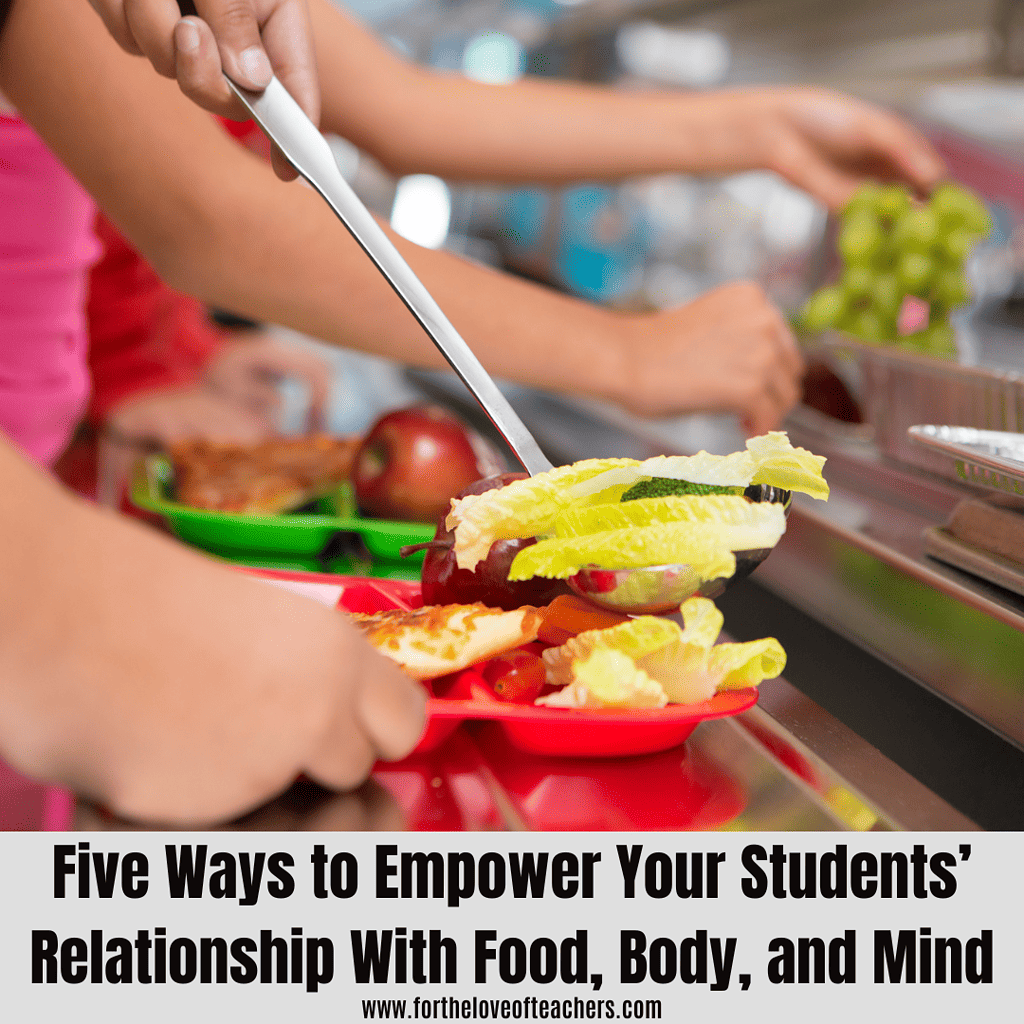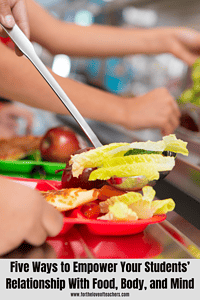A child is 242 times more likely to develop an eating disorder than Type 2 diabetes. This statistic would inspire any parent or educator to strive to make a difference in children’s lives. In fact, over the past decade, the most concerning finding is that rates of eating disorders in children ages 8-12 have increased. Children can struggle with any body size. Educators must therefore rethink current lesson plans and the language that is used in the school setting.
Five ways that diet culture shows up in lesson plans:
- Calorie tracking
- Specific foods to avoid
- Body sizes – overweight, obese
- Sugar and fat consumption as causes of illness or poor health
- Placement of foods into two distinct categories – good/bad or healthy/unhealthy
Such language can cause fear and anxiety. For instance, a 14-year-old client of mine expressed the following: “I have always learned in school about healthy and not-so-healthy foods, and I feel bad about myself when I am eating [something from] the category of unhealthy.” Nutrition is a topic that is not based on a child’s developmental readiness, as until high school, kids simply cannot think so abstractly. Unintentional messages can lead to rules, restrictions, and disordered eating, which can then turn into a serious eating disorder.
How can we educate our students in a sustainable, flexible, and realistic way? Can we shift their mindsets by teaching them a better way to approach their nutrition and mental health long term?
I firmly believe that we can. And that the “Students, Don’t Diet” training program can be one of the solutions. Students need to know that when it comes to mindset, behaviors, and actions, everyone has choices. Based on the 10 intuitive eating principles, the curriculum is weight- and nutrition-inclusive. More than 140 evidence-based studies worldwide have shown the effectiveness of intuitive eating, which includes positive psychological impacts such as improved body image, higher self-esteem, lower rates of disordered eating, and overall healthier well-being.
Five key areas can inspire students to have a better relationship with food and body. Teaching inclusive nutrition education encompasses navigating nutrition misinformation, encouraging mindful eating, building body image resilience, reducing weight stigma and bullying, and supporting self-care behaviors.
Let’s explore these areas in more detail…
Nutrition Misinformation
Diet culture is a system of beliefs about bodies and the desire to lose weight that can impact a person’s behaviors. It values thinness over health and well-being. There are rigid rules, such as specific times to eat, which foods to eat and avoid, how much to eat, and the “don’t eat late at night” myth. These rigid rules along with food “labeling” can promote feelings of guilt and shame. We must teach students to be skeptical of food and health marketing, as companies often do not focus on health, but on profit. Our students could be seeing between 3,000 and 5,000 images a day of “perfect” bodies; consequently, one very critical lesson would be the influences that social media has on nutrition, health, and body image. This constant comparison can take a heavy toll on self-esteem and impact body dissatisfaction.
We live in a culture that profits from our insecurities. Pointing out examples of diet culture can be very powerful. Starting at the young age of 8, kids can learn to become their own detectives. Children who are more educated about diet culture are likely to experience far less fear/anxiety surrounding all the different food categories and acquire more body confidence and satisfaction.
Mindful Eating
Mindful eating is rooted in several principles. These include refraining from any judgment about your eating experience, slowing down and taking your time while eating, and being aware of thoughts, feelings, and physical sensations. By intentionally focusing on the food – and using your senses at the moment – you can gain awareness as to how that food tastes, smells, looks, and feels. This practice supports a healthy mind-body relationship, teaches awareness of body cues, prevents distracted eating or eating past uncomfortable fullness, and provides satisfaction from the eating experience.
Body Image Resilience
We have been sold a complete myth that we are fully in control of the size and shape of our bodies, an inaccurate perception that is the product of our society. We can all live in all types of body sizes. Teaching students about body respect and what our bodies can do for us is more important than what they look like. We can practice unconditional acceptance of all children’s bodies, being sure to avoid any judgmental comments about body size or weight. We can celebrate that all bodies are “good” bodies that deserve respect, love, and acceptance. This teaching could lead to children having greater body appreciation, increased self-esteem, and better overall mental health, as well as less of a tendency toward bullying.
Weight Stigma and Bullying
Weight stigma refers to the societal devaluation of a person because that individual is “overweight” or “obese.” Those who are labeled as such are also often stereotyped with specific characteristics and considered “lazy” or “unmotivated,” and/or lacking in willpower and discipline. This can lead to further discrimination, prejudice, social rejection, and unfair treatment. For children with larger bodies, weight stigma is usually expressed as weight-based victimization, teasing, and bullying.
While weight stigma is widespread and tends to cause considerable harm, it is still often tolerated in our culture due to the misguided belief that stigma and shame will motivate people to lose weight. However, instead of motivating, the stigma contributes to negative behaviors such as binge eating, social isolation, decreased physical activity, increased weight gain, and avoidance of healthcare services, all of which only create additional barriers to making healthy behavior changes.
One way this stigma shows up in schools is through weight checks, which may easily cause shame, embarrassment, body dissatisfaction, and disordered eating behaviors. Replacing the scale with body-positive lessons would be a better option, as it has been shown that students who have a positive or neutral body image and greater self-esteem are more likely to engage in constructive self-care habits.
Self-Care Behaviors
Rather than putting too much emphasis on eating fruits and vegetables, schools can focus on promoting healthy behaviors and self-care activities. Healthy eating should include a variety of foods, including both those that are nutrient-dense and those that aren’t. In addition, they can focus on how students feel when they eat certain foods and what these different foods do for our bodies.
Healthy behaviors include getting adequate sleep, managing stress, learning how to cope with feelings, and incorporating joyful movement and/or some type of exercise. Instead of asking students to track their daily food consumption in Health class, for instance, schools can have them record what types of healthy behaviors they engage in over an assigned time frame (say, a few weeks). While lessons that involve tracking calories and sugar/fat intake are likely to create anxiety, shame, guilt, and possibly cause feelings of failure, lessons that encourage facilitating meaningful relationships, having meals and snacks every few hours, honoring hunger and fullness, and consuming fiber and sufficient amounts of water can provide a feeling of confidence and empowerment.
These are five effective ways for schools to empower their students to develop a healthy relationship with food, body, and mind. Perhaps we can eventually end the legacy of diet culture. In the meantime, though, we must try to prevent it from entering and impacting yet another generation. Of course, schools cannot do this alone. Parents, pediatricians, and mental health professionals must all be educated, too; it needs to be a collaborative effort. We owe that much to the next generation of students.
Click here to download the nutrition and mental health Myth vs. Fact sheet for you and your students.
Click here if you would like to learn more about Students, Don’t Diet.
Click here if you would like to download the Nine to Nourished: A Recipe Roadmap guide.
 About the Author: A Registered Dietitian, Lauren Dorman is a Nutrition Therapist who has 20 years of experience working alongside children and adults struggling with body image and self-esteem, as well as disordered and emotional eating. Lauren is the owner of the company Don’t Diet Dietitian, through which she offers both individual and group counseling. In addition to speaking regularly at webinars, conferences, and wellness business events, she provides professional development workshops for local schools. She believes that everyone deserves to have access to a Registered Dietitian – an expert in nutrition science who can help navigate nutrition misinformation, teach sustainable health habits, and focus on a self-care behavioral approach toward healing one’s relationship with food, mind, and body.
About the Author: A Registered Dietitian, Lauren Dorman is a Nutrition Therapist who has 20 years of experience working alongside children and adults struggling with body image and self-esteem, as well as disordered and emotional eating. Lauren is the owner of the company Don’t Diet Dietitian, through which she offers both individual and group counseling. In addition to speaking regularly at webinars, conferences, and wellness business events, she provides professional development workshops for local schools. She believes that everyone deserves to have access to a Registered Dietitian – an expert in nutrition science who can help navigate nutrition misinformation, teach sustainable health habits, and focus on a self-care behavioral approach toward healing one’s relationship with food, mind, and body.
Thanks for reading!
If you like it, then pin it!

Christine Weis is a passionate educator, classroom management coach, wife, and mom of two busy boys. She enjoys teaching, writing, and creating resources for teachers.







I would love to apply all your great tips on myself. I would start with mindful eating so that I can avoid binging sessions in times of emotional crisis.
Though I am not a teacher or have children I really appreciated this post. I believe school and the educators in should make it a point to educate children on good eating habits and help them to develop a positive body image. Because you are right, there is a staggering amount is very young children with eating disorder, which is both shocking and scary.
Ooohhhh yes, I so much agree with Lauren! We live in a time where children’s insecurities are up for sale to whoever wants them. We need to empower children to feel good about the food before them as well as their bodies.
It’s so important for schools to prioritize the well-being of their students and empower them to develop healthy relationships with food, body, and mind. I love the idea of working collaboratively with parents, paediatricians, and mental health professionals to prevent the negative impact of diet culture on the next generation. It’s heartening to see people coming together to make a positive difference in the world.
These are all really great and very effective ways! I’m gonna take note of this and also share this with my friend who’s a teacher
I love this because so many people especially now have such a bad relationship wiht food!
This article was a fantastic resource for empowering students’ relationship with food, body, and mind. The practical tips and strategies provided valuable insights on fostering a healthy and positive mindset. I’m excited to implement these ideas in my classroom. Great job!
These are all really good ways to help teach children to develop good relationships with food. Self care is a biggie you hear about all the time and healthy behavior in regards to eating and exercise is very important to encourage early on.
I love the idea of helping them through this topic at school along with at home. It can be so hard on kids & even adults with how much focus gets put onto diet culture and body images.
Teaching body image resilience is so important! As crazy as it sounds, I’ve had the same body perception issues since I was a pre-teen! It’s better to learn early on to not do that.
Unfortunately kids (and adults) are surrounded by an abundance of products that claim to be food and are created to entice them. It’s definitely challenging.
Thank you for highlighting these five ways to empower students’ relationships with food, body, and mind. Sometimes I think kids don’t always get the TLC they need at home and it’s wonderful educators can help out.
I love this so much! Being a teacher is about so much more than just drilling facts into the kids’ heads. It’s about helping them in all aspects of life.